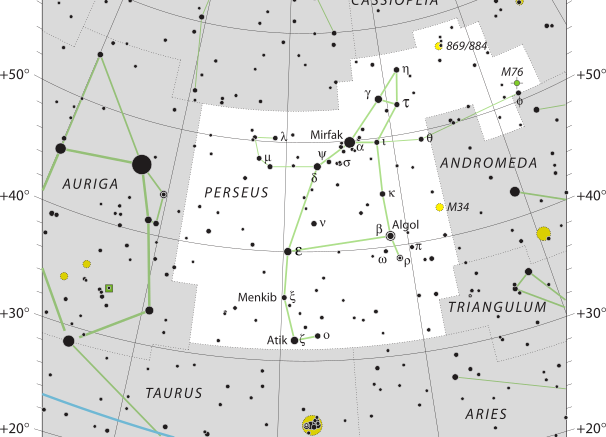Located in the northern sky, Perseus is a constellation that is named after the Greek mythological hero Perseus. It is one of the 48 ancient constellations listed by the 2nd-century astronomer Ptolemy, and remains part of the 88 modern constellations. It is located near several other constellations named after ancient Greek legends surrounding Perseus.
The galactic plane of the Milky Way passes through Perseus, whose brightest star is the yellow-white supergiant Alpha Persei, which is also known as Mirfak. The constellation gives its name to the Perseus cluster, a massive galaxy cluster located 250 million light-years from Earth. It hosts the annual Perseids meteor shower, which is one of the most prominent meteor showers in the sky.
Perseus covers 615 square degrees in the night sky, makes the constellation the 24th largest constellation in size. It appears prominently in the northern sky during the Northern Hemisphere’s spring, with the main asterism consisting of 19 stars.
| Applicable Information | |
| Visibility In Pacific Northwest | September to February |
| Best Times To View | November and December |
| Right Ascension | 3h |
| Declination | +45° |
| Area | 615 square degrees |
| Main Stars | 19 |
| Brightest Object | α Per |
| Meteor showers | Perseids, and September Perseids |
| Messier objects | 2 |
| Neighboring Constellations | Aries, Taurus, Auriga, Camelopardalis, Cassiopeia, Andromeda, Triangulum |
Myths
In Greek mythology, Perseus was the son of Danaë, who was sent by King Polydectes to bring the head of Medusa the Gorgon, whose visage caused all who gazed upon her to turn to stone. Perseus slew Medusa in her sleep, and Pegasus and Chrysaor appeared from her body.[1] Perseus continued to the realm of Cepheus whose daughter Andromeda was to be sacrificed to Cetus the sea monster.
Perseus rescued Andromeda from the monster by killing it with his sword.[2] He turned Polydectes and his followers to stone with Medusa’s head and appointed Dictys the fisherman king.[1]
In Neo-Assyrian Babylonia, the constellation was known as the Old Man constellation, which was then associated with East in the MUL.APIN.
Four Chinese constellations are contained in the area of the sky identified with Perseus.
In Polynesia, Perseus was not commonly recognized as a separate constellation; however, the people of the Society Islands, did called the constellation Faa-iti, meaning “Little Valley”.
Stars
The galactic plane of the Milky Way passes through the constellation; however, this is much less obvious than elsewhere in the sky as it is mostly obscured by molecular clouds. The Perseus Arm is a spiral arm of the Milky Way galaxy and stretches across the sky from the constellation Cassiopeia through Perseus and Auriga to Gemini and Monoceros.
Within the Perseus Arm lie two open clusters, which are NGC 869 and NGC 884, that are known as the Double Cluster. These open clusters are easily visible through binoculars and small telescopes.
M34 is an open cluster that appears at magnitude 5.5, which contains about 100 stars scattered over a field of view larger than that of the full moon. M34 can be resolved with good eyesight but is best viewed using a telescope at low magnifications.
Also called the Little Dumbbell Nebula, M76 is a planetary nebula appears two arc-minutes by one arc-minute across. Also in the constellation can be found NGC 1499, also known as the California Nebula, which is an emission nebula. It is very difficult to observe visually because its low surface brightness makes it appear dimmer than most other emission nebulae.
Perseus contains some notable galaxies including the barred spiral galaxy of NGC 1023, which is the principal member of the NGC 1023 group.
NGC 1260 is a spiral galaxy of either the lenticular or tightly-wound variety. is a member of the Perseus Cluster, which is a massive galaxy cluster The Perseus Cluster is the closest major cluster to the Earth. Located in the Perseus Cluster, NGC 1275 is a Seyfert galaxy containing an active nucleus that produces jets of material, surrounding the galaxy with massive bubbles.
The Perseids are a prominent annual meteor shower that appear to radiate from Perseus from mid-July, peaking in activity between August 9th to 14th each year. The Perseids are one of the most reliable meteor showers of the year, with the best viewing time being between sunset and 11pm.
Make sure to check out other articles on the site, including a brief introduction to constellations, other constellation articles, and more!
Sources
[1] = Ridpath, I. “Star Tales – Perseus”.
[2] = Ridpath, I. “Star Tales – Andromeda”

Be the first to comment on "Perseus"